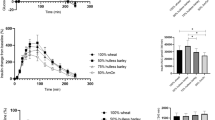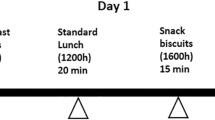Abstract
Background/Objectives:
Glycaemic responses are influenced by carbohydrate absorption rate, type of monosaccharide absorbed and the presence of fat; the effect of some of these factors may be modulated by metabolic differences between subjects. We hypothesized that glycaemic index (GI) values are affected by the metabolic differences between subjects for foods containing fructose or fat, but not for starchy foods.
Subjects/Methods:
The GI values of white bread (WB), fruit leather (FL) and chocolate-chip cookies (CCC) (representing starch, fructose and fat, respectively) were determined in subjects (n=77) recruited to represent all 16 possible combinations of age (⩽40, >40 years), sex (male, female), ethnicity (Caucasian, non-Caucasian) and body mass index (BMI) (⩽25, >25 kg/m2) using glucose as the reference. At screening, fasting insulin, lipids, c-reactive protein (CRP), aspartate transaminase (AST) and waist circumference (WC) were measured.
Results:
There were no significant main effects of age, sex, BMI or ethnicity on GI, but there were several food × subject-factor interactions. Different factors affected each food's area under the curve (AUC) and GI. The AUC after oral glucose was related to ethnicity, age and triglycerides (r2=0.27); after WB to ethnicity, age, triglycerides, sex and CRP (r2=0.43); after CCC to age and weight (r2=0.18); and after FL to age and CRP (r2=0.12). GI of WB was related to ethnicity (r2=0.12) and of FL to AST, insulin and WC (r2=0.23); but there were no significant correlations for CCC.
Conclusions:
The GI values of foods containing fructose might be influenced by metabolic differences between –subjects, whereas the GI of starchy foods might be affected by ethnicity. However, the proportion of variation explained by subject factors is small.
This is a preview of subscription content, access via your institution
Access options
Subscribe to this journal
Receive 12 print issues and online access
$259.00 per year
only $21.58 per issue
Buy this article
- Purchase on Springer Link
- Instant access to full article PDF
Prices may be subject to local taxes which are calculated during checkout





Similar content being viewed by others

References
Aldughpassi A, Wolever TMS (2009). Effect of coffee and tea on the glycaemic index of foods: no effect on mean but reduced variability. Brit J Nutr 101, 1282–1285.
Bajaj M, Suraamornkul S, Pratipanawatr T, Hardies LJ, Pratipanawatr W, Glass L et al. (2003). Pioglitazone reduces hepatic fat content and augments splanchnic glucose uptake in patients with type 2 diabetes. Diabetes 52, 1364–1370.
Barclay AW, Petocz P, McMillan-Price J, Flood VM, Prvan T, Mitchell P et al. (2008). Glycemic load and chronic disease risk-a meta-analysis of observational studies. Am J Clin Nutr 87, 627–637.
Benton D, Ruffin M-P, Lassel T, Nabb S, Messaoudi M, Vinoy S et al. (2003). The delivery rate of dietary carbohydrates affects cognitive performance in both rats and humans. Psychopharmacology 166, 86–90.
Björk I, Liljeberg H, Östman E (2000). Low glycaemic-index foods. Brit J Nutr 83 (Suppl 1), S149–S155.
Bruttomesso D, Pianta A, Mari A, Valerio A, Marescotti MC, Avogaro A et al. (1999). Restoration of early rise in plasma insulin levels improves the glucose tolerance of Type 2 diabetic patients. Diabetes 48, 99–105.
Chen MR, Bergman RN, Pacini G, Porte D (1985). Pathogenesis of age-related glucose intolerance in man: insulin resistance and decreased β-cell function. J Clin Endocrinol Metab 60, 13–20.
Clausen JO, Borch-Johnsen K, Ibsen H, Bergman RN, Hougaard P, Winther K et al. (1996). Insulin sensitivity index, acute insulin response, and glucose effectiveness in a population-based sample of 380 young healthy caucasians: analysis of the impact of gender, body fat, physical fitness and life-style factors. J Clin Invest 98, 1195–1209.
Cody RP, Smith JK (1997). Applied Statistics and the SAS Programming Language 4th edn Prentice Hall: Upper Saddle River, NJ.
Coutinho M, Gerstein HC, Wang Y, Yusuf S (1999). The relationship between glucose and incident cardiovascular events. A metaregression analysis of published data from 20 studies of 95,783 individuals followed for 12.4 years. Diabetes Care 22, 233–240.
Decode study group on behalf of the European Diabetes Epidemiology Group (1999). Glucose tolerance and mortality: comparison of WHO and American diabetes association diagnostic criteria. Lancet 354, 617–621.
DeMarco HM, Sucher KP, Cisar CJ, Butterfield GE (1999). Pre-exercise carbohydrate meals: application of glycemic index. Med Sci Sports Exerc 31, 164–170.
DeVries JW (2007). Glycemic index: the analytical perspective. Cereal Foods World 52, 45–49.
Dickinson S, Colagiuri S, Faramus E, Patocz P, Brand-Miller JC (2002). Postprandial hyperglycemia and insulin sensitivity differ among lean young adults of different ethnicities. J Nutr 132, 2574–2579.
Ferrannini E, Balkau B (2002). Insulin: in search of a syndrome. Diab Med 19, 724–729.
Haffner SM (2006). The metabolic syndrome: inflammation, diabetes mellitus, and cardiovascular disease. Am J Cardiol 97, 3A–11A.
Haffner SM, D’Agostino R, Mohammed F, Saad MF, Rewers M, Mykkanen L et al. (1996). Increased insulin resistance and insulin secretion in nondiabetic African-Americans and Hispanics compared with non-Hispanic whites: the insulin resistance atherosclerosis study. Diabetes 45, 742–748.
Hare-Bruun H, Nielson BM, Grau K, Oxlund AL, Heitmann BL (2008). Should glycemic index and glycemic load be considered in dietary recommendations? Nutr Rev 66, 569–590.
Harris MI, Flegal KM, Cowie CC, Eberhardt MS, Goldstein DE, Little RR et al. (1998). Prevalence of diabetes, impaired fasting glucose, and impaired glucose tolerance in US adults. The third national health and nutrition examination survey, 1988–1994. Diabetes Care 21, 518–524.
Hwang J-H, Perseghin G, Rothman DL, Cline GW, Magnusson I, Falk Petersen K et al. (1995). Impaired net hepatic glycogen synthesis in insulin-dependent diabetic subjects during mixed meal ingestion. A 13C nuclear magnetic resonance spectroscopy study. J Clin Invest 95, 783–787.
Jenkins DJA, Wolever TMS, Taylor RH, Barker HM, Fielden H, Baldwin JM et al. (1981). Glycemic index of foods: a physiological basis for carbohydrate exchange. Am J Clin Nutr 34, 362–366.
Laakso M (1993). How good a marker is insulin level for insulin resistance? Am J Epidemiol 137, 959–965.
Lam TKT, Gutierrez-Juarez R, Pocai A, Bhanot S, Tso P, Schwartz GJ et al. (2007). Brain glucose metabolism controls the hepatic secretion of triglyceride-rich lipoproteins. Nature Med 13, 171–180.
Lê KA, Tappy L (2006). Metabolic effects of fructose. Curr Opin Clin Nutr Metab 9, 469–745.
Lewis GF, Carpentier A, Adeli K, Giacca A (2002). Disordered fat storage and mobilization in the pathogenesis of insulin resistance and type 2 diabetes. Endocr Rev 23, 201–229.
Mathers J, Wolever T (2002). Digestion and metabolism of carbohydrates. In: Gibney MJ, Vorster HH and Kok FJ (eds) Introduction to Human Nutrition. Blackwell Science: Oxford, UK, pp 69–80.
Moghaddam E, Vogt JA, Wolever TMS (2006). The effects of fat and protein on glycemic responses in nondiabetic humans vary with waist circumference, fasting plasma insulin, and dietary fiber intake. J Nutr 136, 2506–2511.
Owen B, Wolever TMS (2003). Effect of fat on glycaemic responses in normal subjects: a dose-response study. Nutr Res 23, 341–347.
Perry GH, Dominy NJ, Claw KG, Lee AS, Fiegler H, Redon R et al. (2007). Diet and the evolution of human amylase gene copy number variation. Nat Genet 39, 1256–1260.
Pi-Sunyer FX (2002). Glycemic index and disease. Am J Clin Nutr 76 (Suppl), 290S–298S.
Ross SW, Brand JC, Thorburn AW, Truswell AS (1987). Glycemic index of processed wheat products. Am J Clin Nutr 46, 631–655.
Serkova NJ, Jackman M, Brown JL, Liu T, Hirose R, Roberts JP et al. (2006). Metabolic profiling of livers and blood from obese Zucker rats. J Hepatol 44, 956–962.
Su CC, Wang K, Hsia TL, Chen CS, Tung TH (2006). Association of nonalcoholic fatty liver disease with abnormal aminotransferase and postprandial hyperglycemia. J Clin Gastroenterol 40, 551–554.
Wolever TMS (2006). The Glycaemic Index: A Physiological Classification of Dietary Carbohydrate. CABI International: Wallingford, UK, p 26.
Wolever TMS (2008). The glycemic index in the management of obesity. Endocrinol Rounds 8 URL: www.endocrinologyrounds.ca.
Wolever TMS, Gibbs AL, Spolar M, Hitchner EV, Heimowitz C (2006a). Equivalent glycemic load (EGL): a method for quantifying the glycemic responses elicted by low carbohydrate foods. Nutr Metab 3, 33.
Wolever TMS, Ip B, Moghaddam E (2006b). Measuring glycaemic responses: duplicate fasting samples or duplicate measures of one fasting sample? Brit J Nutr 96, 799–802.
Wolf BW, Humphrey PM, Hadley CW, Maharry KS, Garleb KA, Firkins JL (2002). Supplemental fructose attenuates postprandial glycemia in Zucker fatty fa/fa rats. J Nutr 132, 1219–1223.
Wu C, Khan SA, Lange AJ (2005). Regulation of glycolysis—role of insulin. Exp Gerontol 40, 894–899.
Young KWH, Wolever TMS (1998). Effect of volume and type of beverage consumed with a standard test meal on postprandial blood glucose responses. Nutr Res 18, 1857–1863.
Acknowledgements
This work was supported by Ag West Bio, Inc., Saskatoon, Sasketchewan, Canada. Strawberry Fruit Bars were kindly donated by SunOpta, Inc., Brampton ON, and Montana Chocolate Chip Cookies were kindly donated by Kinnikinnic Foods Inc., Edmonton, AB. TMSW, ALJ and VV are principals and part-owners of Glycemic Index Laboratories, Inc. (GIL). JC is an employee of GIL.
Author information
Authors and Affiliations
Corresponding author
Additional information
Contributors: TMSW conceived of the study, AJ, VV and JC contributed to its ultimate design. TMSW, AJ and VV obtained funding. TMSW analysed the data and drafted the manuscript which AJ, VV and JC reviewed for critical content.
Rights and permissions
About this article
Cite this article
Wolever, T., Jenkins, A., Vuksan, V. et al. The glycaemic index values of foods containing fructose are affected by metabolic differences between subjects. Eur J Clin Nutr 63, 1106–1114 (2009). https://doi.org/10.1038/ejcn.2009.30
Received:
Revised:
Accepted:
Published:
Issue Date:
DOI: https://doi.org/10.1038/ejcn.2009.30
Keywords
This article is cited by
-
The effect of oat β-glucan on postprandial blood glucose and insulin responses: a systematic review and meta-analysis
European Journal of Clinical Nutrition (2021)
-
Effect of ethnicity on glycaemic index: a systematic review and meta-analysis
Nutrition & Diabetes (2015)
-
The use of different reference foods in determining the glycemic index of starchy and non-starchy test foods
Nutrition Journal (2014)
-
Glycemic index claims on food labels: review of Health Canada's evaluation
European Journal of Clinical Nutrition (2013)
-
Is glycaemic index (GI) a valid measure of carbohydrate quality?
European Journal of Clinical Nutrition (2013)


